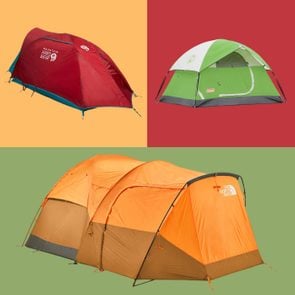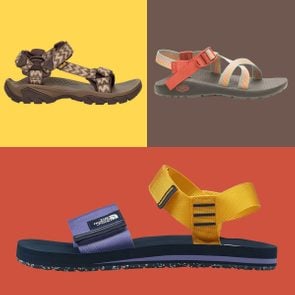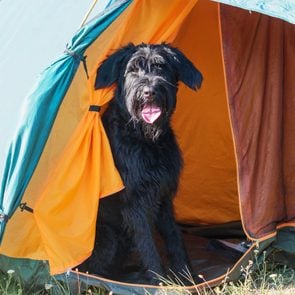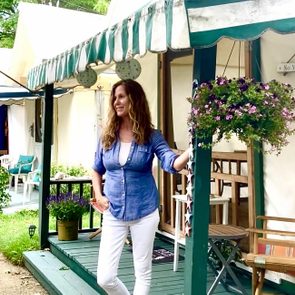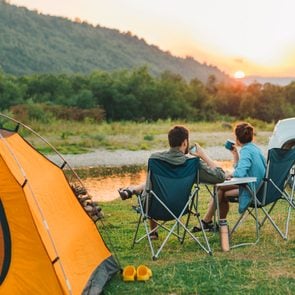Camping for Beginners: Everything First-Timers Need to Know for a Fun, Safe Experience
Updated: Mar. 14, 2024
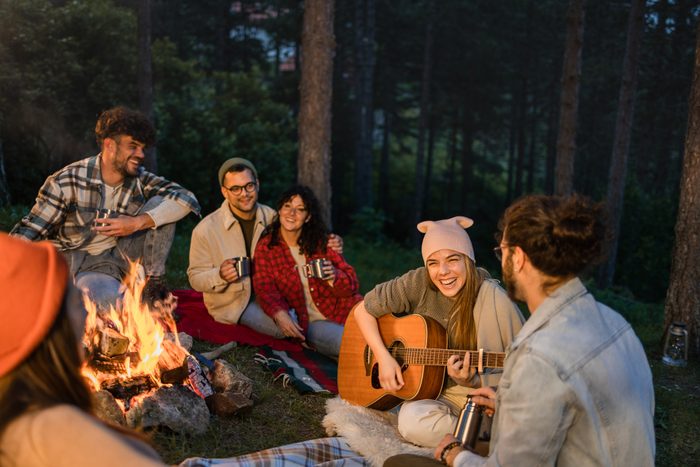
New to the outdoors? This guide for beginning campers will help you avoid bugs, bears and soggy tents so you can focus on making great memories.
Though I don’t recall much from the one and only time my family went camping when I was a kid, I remember clear as day my first camping trip as an adult. It was terrible.
I should have known from the start it would be a disaster. Problem No. 1: I assumed my friend’s tent would be large enough to fit me too. But while her small tent was suitable for her petite frame, at 5 foot 8, I had to keep the front flap cracked all night to stick my feet out. This meant mosquitoes could get in our tent. We both woke up—from what little sleep we got—covered in bites. And things only got worse from there.
Fast forward 10 years, and I’m now a self-described camping enthusiast. Because I learned many lessons the hard way, I’m eager to share my tips for camping for beginners to encourage and support newbies. And there are a lot of you! According to The Dyrt’s 2023 Camping report, 7.2 million people went camping for the first time in 2022.
From where to camp and what to pack to what to wear and how to prepare for emergencies, here’s everything you need to know to plan a fun and safe camping trip as a beginner.
On This Page
Types of camping
For some, the only acceptable way to enjoy the outdoors is luxury camping in a big tent with a comfy bed. For others, such an experience hardly qualifies as camping, and they prefer little more than a simple tent and a backpack full of supplies.
To help you sort out which one is right for you, here’s a glossary of the most popular camping styles.
Tent camping
Tent camping is the most popular form of camping for a few reasons. For starters, it tends to be the cheapest and most flexible option, since you can typically pack up and go (once you’ve invested in the necessary equipment). Tents range from a simple one-person style that can be set up and broken down in minutes to a spacious setup that can accommodate an entire family. The downside of tent camping is that it can be unpleasant during cold and wet weather, you might not have ready access to a bathroom and you need to book peak-season reservations at popular campsites, especially at national parks, weeks to months in advance.
Glamping
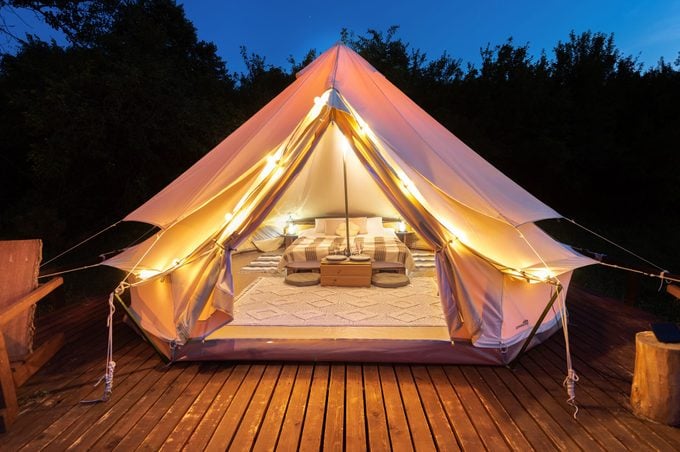
“Glamorous camping,” better known as glamping, is comfortable camping under a canvas tent, teepee, yurt, dome or other unique structure. Beds, linens and pillows are typically provided, and many glampsites also include on-site bathrooms, kitchens and firepits. Glamping is a good way to introduce hesitant campers to the idea of sleeping under the stars, or for seasoned summer campers to experiment with winter camping, which tends to be more challenging. Since everything is included and set up in advance, glamping may not give a true camping experience—though that’s a plus for some! One con: Some glampsites cost as much as or more than a night at a hotel.
Car camping
Car camping involves loading your car or van with supplies and showing up at your camp spot. While you could set up a tent next to your car, if your car is large enough, you could sleep in it (just be sure to first check local laws). Car camping is a fairly easy form of camping that doesn’t require too much advance planning, and you don’t need to lug all your essentials in a backpack. However, because you’re sticking close to your car, you may also be stuck next to loud campers who also have the same plan.
Backcountry camping
Want to avoid crowds and really get away from it all? Hike out to the backcountry, where there are no vehicles or paved roads. Backcountry or wilderness camping offers silence, tranquility and unrestricted access to nature that is impossible to find at crowded campsites. For a successful trip, you’ll have to choose your route and determine in advance where you can camp and what to pack. Your packing list should include food, first aid equipment, a tent, camp cookware, food and other supplies, all of which must be carried in—and out—on your back. It probably goes without saying, but backcountry camping should be left to experienced campers.
RV camping
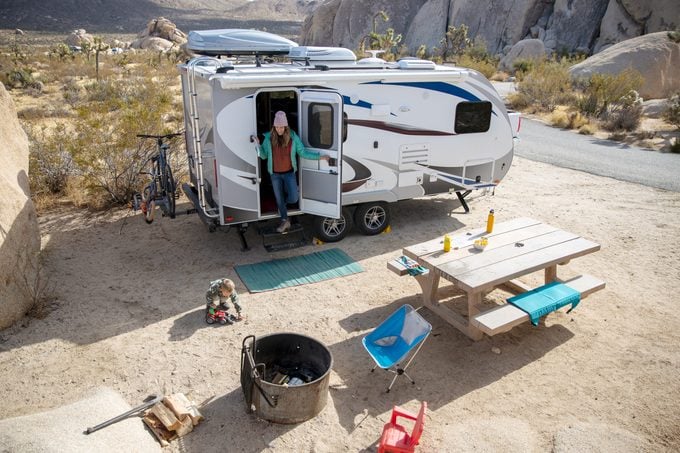
RV camping offers the convenience of having ready access to a bed, kitchen and toilet and is an easy way to take an extended road trip. However, it also tends to be the most expensive option. Whether you’re purchasing or renting an RV, you’ll also need to factor in the cost of fuel required to power a large RV. Plus, there are the additional challenges of driving and parking such a large vehicle. While many RV parks offer water and electricity hookups, you can also take your RV dry-camping or boondocking, which means camping outside of a traditional RV park without access to those basics.
Choosing a campsite
For beginning campers, sticking close to home at a popular campsite with more facilities, such as bathrooms, grills and trash disposal, is your best bet. Chances are you’ll feel most comfortable setting up your tent near other campers and at a location with an on-site director. Speaking of which, if you stay at a campground with an information center or reservation office, book a campsite near the main building for added security—and hands-on advice.
If you’re game to “rough it” and prefer the sound of birds, squirrels and other wildlife to people, research campsites off the beaten path, such as free camping sites in wilderness areas or on National Forest land. Should you go the remote route, just be sure you pack everything you’ll need to be off the grid.
Pitching your tent
Once you’re at your campsite, you’ll still need to find the best place to pitch your tent. Seek out a level spot so you won’t have to sleep off-kilter. Look up and around the area too—you don’t want to pitch your tent under a tree with dead branches that could fall or near large rocks that look like they could topple, advises Louis Juers, the family campout program specialist with Arizona State Parks and Trails. He also suggests clearing the area of sticks, rocks and other debris that could damage the bottom of your tent. This includes small rocks that “could become very uncomfortable at 2 a.m.,” he adds.
Before you set up your tent, lay a tarp down over your intended foundation. This provides a layer of padding between any rocks you missed, the cold hard ground and your tent. It will also help prevent any water from accumulating in your tent should it rain during your trip.
Camping essentials

The camping gear you need depends on the type of camping you’ll be doing, the season and how long you plan to camp. A general camping packing list includes:
Sleeping gear
- Tent
- Cot
- Sleeping bag
- Sleeping pad/mattress
- Pillow
- Blanket
- Ear plugs
- Eye mask
Cookware
- Pots, pans and mixing bowls
- Coffee pot
- Camp dishes
- Utensils
- Camp stove
- Fuel for the stove
- Matches
- Firestarter
- Water filter
- Several gallons of water
- Biodegradable dish detergent
Personal care items
- Toiletries (toothpaste, camp soap, deodorant)
- Bug spray
- Sunblock
Other items
- Lantern/headlamp
- Utility knife
- Disinfectant wipes
- Portable charger
- Camping chair
- Trash bags
- Ziplock bags
- Bear spray
- Waterproof dry bag
What to wear
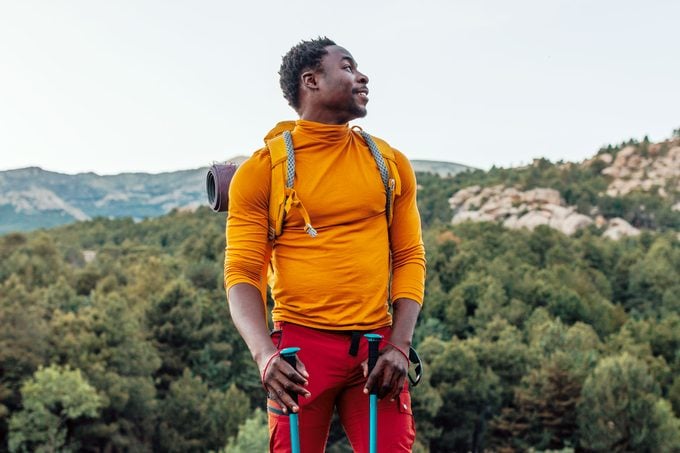
Like your campsite packing list, your clothing checklist depends on the season, how long you’ll be camping and which activities, such as kayaking or hiking, you have planned. It’s always smart to pack layers, especially when camping in the mountains, where temperatures can fluctuate throughout the day.
Here is a general checklist:
- Short-sleeved tops
- Long-sleeved tops
- Hiking pants
- Hiking boots
- Hiking sandals
- Hiking socks
- Camping shoes
- Underwear
- Long underwear/leggings
- Waterproof shell/jacket
- Sun-protective hat
- Sunglasses
- Fleece or hoodie
- Gloves
- Waterproof dry bag
- Daypack or a light backpack
What to eat
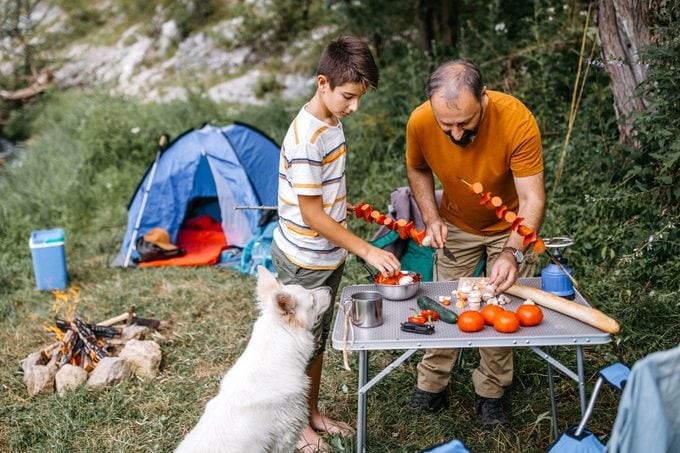
Though I own virtually every item of camp cookware imaginable, I’ll admit that nine times out of ten, I do everything possible to avoid cooking at the campsite. While I like camp-fired pizza, cornbread, veggie burgers and other classic camp fare, I enjoy those foods a lot more when other people cook them. When left to my own devices, I pack foods that are ready-to-eat or foods I can prepare at home to take with me, like homemade hummus, bean-and-corn salad and pasta salad. Not only does this mean less time cooking at the campsite, but I can pack fewer items and don’t have as much to clean up.
If you’re going to be doing any dishes while camping, use biodegradable, camp-friendly soap and wash dishes (and your body, for that matter) in a bucket or bin that you fill with water at least 200 feet away from any natural water source. Why? Because even biodegradable soap isn’t meant for our rivers, streams and lakes and the aquatic life that calls them home. Sometimes, if my friends and I are only camping for a day or two, we’ll just pack our dirty dishes up in our bags to wash when we get home.
Here’s a list of some of my go-to, no-cook meals and snacks for camping:
- Overnight oats
- Bagels with cream cheese
- Graham crackers with peanut butter
- Peanut butter and jelly sandwiches
- Cold-cut sandwiches (pack items separately to avoid soggy bread)
- Pasta salads
- Bean salads
- Tuna salad (on a sandwich or in pasta)
- Fresh fruit
- Pre-sliced veggies (celery sticks, baby carrots)
- Hummus
- Chips and salsa
- Beef jerky
- Summer sausage
- Canned sardines
- Nuts
- Cheese sticks
- Crackers
- Energy bars
- Ramen noodles
- S’mores ingredients (chocolate bars, graham crackers and marshmallows)
How to clean up
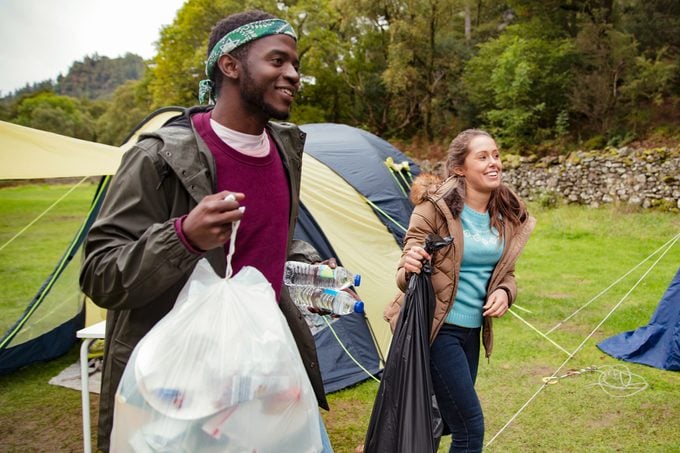
Whether you packed all pre-made food or grilled up a multi-course meal, proper trash and waste disposal is essential to keeping your campsite clean and pest- and animal-free. While you’ll want to do a thorough clean-up before heading home, you should also clean as you go, gathering and disposing of all trash after each meal. If your campsite doesn’t provide trash facilities, seal your trash in sturdy, sealable Ziploc freezer bags, then store them away from your tent hidden in the brush or in some rocks until it’s time to leave. Dispose of them properly when you reach civilization, be it a gas station, ranger station, truck stop or home.
If you’re camping in bear-prone areas (more likely when backcountry camping), you’ll need to store food items and food waste in a bear canister, which should be stashed at least 100 yards downwind of your tent.
What to do
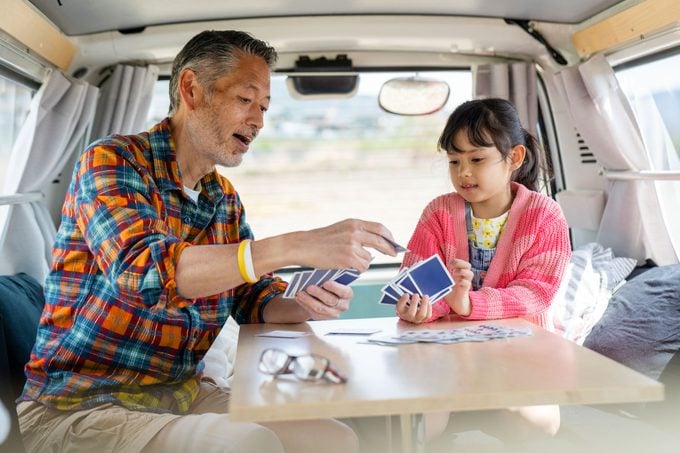
Personally, there’s nothing I enjoy more than reading while camping, so I always pack a good book and a headlamp so I can read as late (or early) as I want. For others, camping is an opportunity to spend electronic-free quality time with friends and family while playing camping games. Whether your group includes young children or only adults, here’s a list of camp-friendly activities:
- Sing campfire songs
- Tell campfire stories
- Play cards
- UNO
- Cards Against Humanity
- “Two Truths and a Lie”
- Frisbee
- Badminton
- Cornhole
- Lawn bowling
- Volleyball
- Capture the flag
- Build a fort
- DIY obstacle course
- DIY scavenger hunt
- Stargazing
Rules for camping safely
To prevent unwanted potentially dangerous situations like wildfires and bear attacks, avoid rude camping habits like leaving food and fires unattended.
Weather safety
Check the weather before heading out to make sure you pack the right gear. After all, we can’t control the weather, but we can control what we pack—the quality and quantity of your gear will determine how safe and comfortable you are. For a rainy trip, a fully waterproof and windproof tent is essential, as are waterproof dry bags and Ziplock storage bags for electronics. Bring fully charged headlamps, flashlights and/or lanterns or a spare set of batteries. And if the forecast includes very severe weather, there’s no shame in postponing your trip.
Fire safety
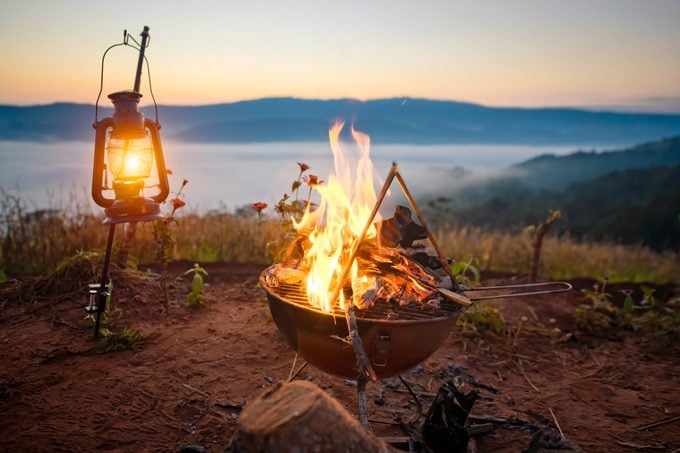
While checking the weather, also look to see if there are any fire restrictions, suggests Juers. If conditions are safe, he advises using or making a fire ring to contain the fire. Before lighting a campfire, make sure there are no potential fire hazards nearby, such as dry grass, overhanging branches, root balls or exposed roots.
If you’ve never built a fire, practice before heading out for your first camping trip. Gather twigs, leaves, small sticks and downed firewood (never cut down a living tree), or purchase firewood from the campground or a local store. In order to not introduce invasive species, it’s critical to only use local firewood and not bring wood from home.
Never leave a fire unattended. Extinguish it completely before departing on a hike or turning in for the night. To do so, Juers suggests dousing your fire with water and stirring it with a stick until it feels cool to the back of your hand held close to the coals.
Wildlife safety
One of the best perks of camping is being close to nature and wildlife. Understand, however, that animals do not exist for our entertainment, so for everyone’s safety—including that of the animals—it’s important to keep a safe distance.
Juers suggests following the thumb rule: Hold your thumb out at arm’s length while looking at the animal. “If your thumb doesn’t completely cover the animal, you need to back up!” he warns. Also important: Don’t feed any wild animals.
If you’re camping in bear country, secure all fragrant items (food and any scented soap and toiletries) in a bear canister, carry bear spray and know what to do if you see a bear.
Best places to camp
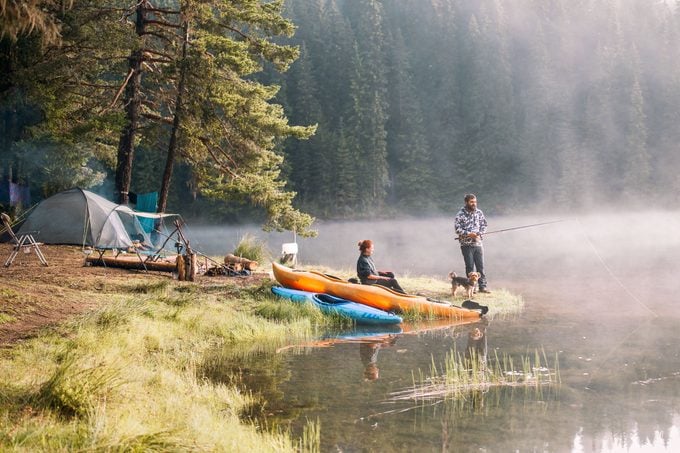
There’s no single best place to camp, because the notion of “best” is up to you! Some people like to be surrounded by trees, while others may want to be near water. Some like a very secluded area, while others prefer the camaraderie of other campers. Consider what you value the most—be it solitude or proximity to modern bathrooms—and plan accordingly. Happy camping!
Sources:
- The Dyrt 2023 Camping Report
- Louis Juers, Arizona State Parks and Trails
- Mary Leavines, of the all-female adventure tour company Adventures in Good Company

